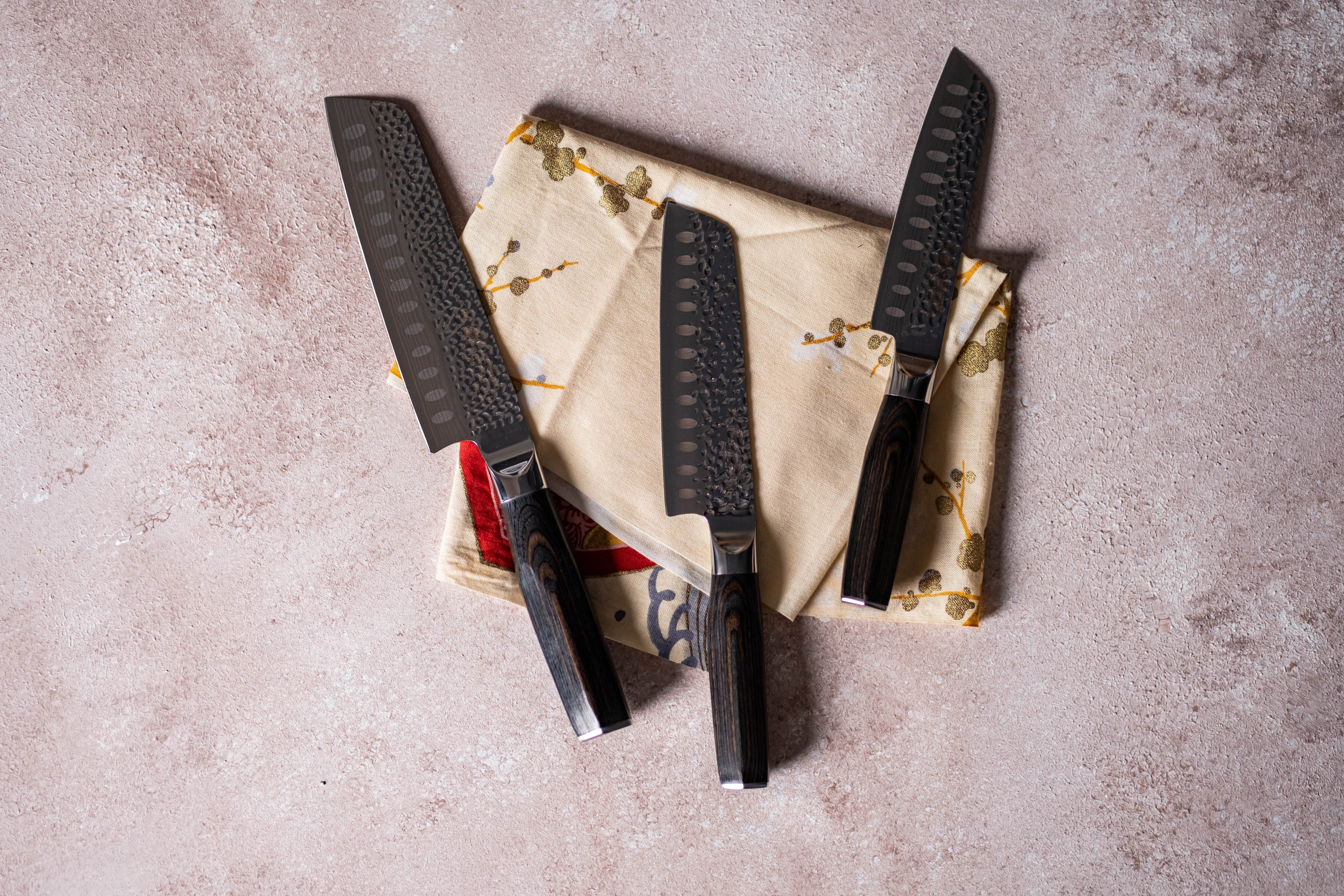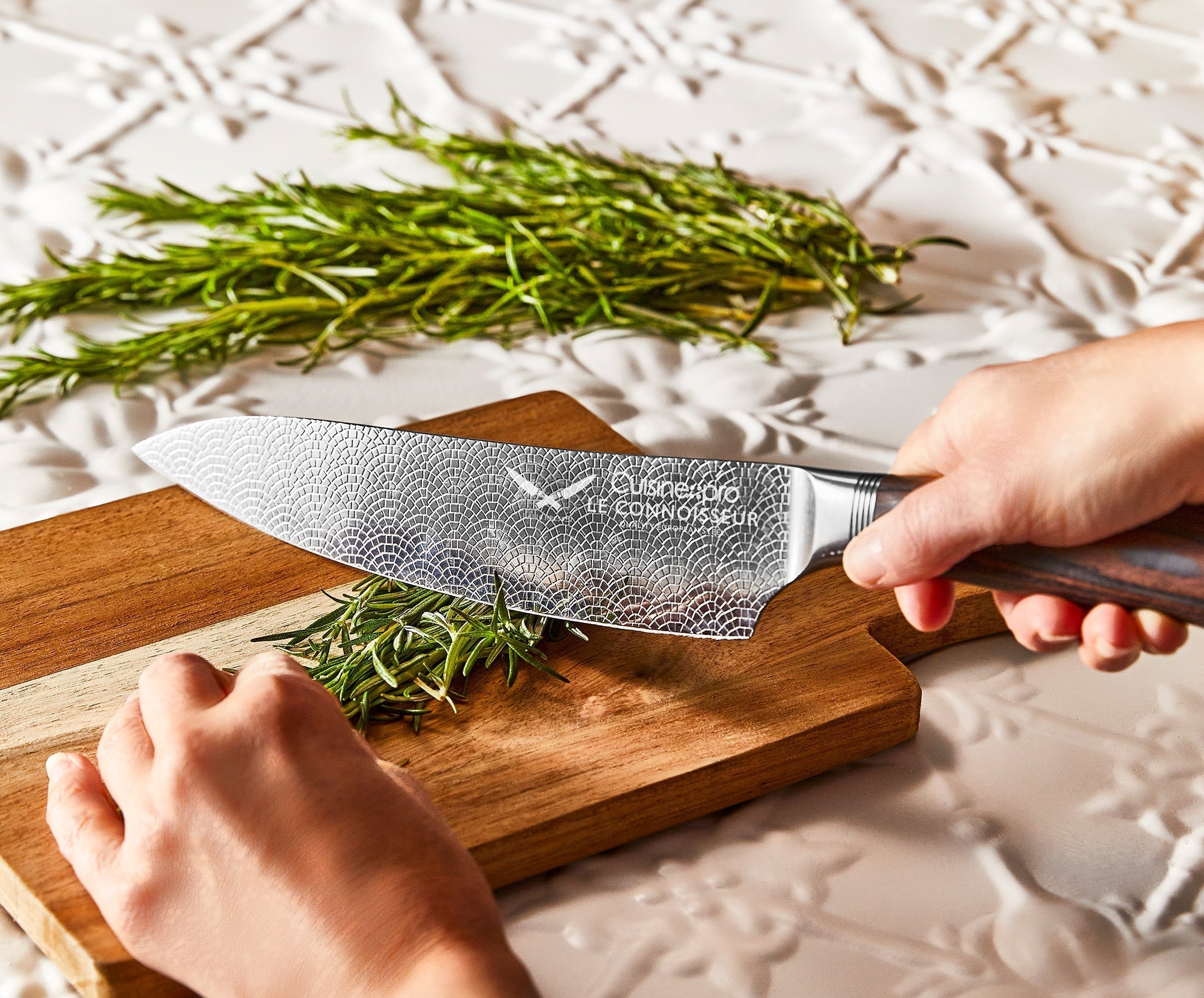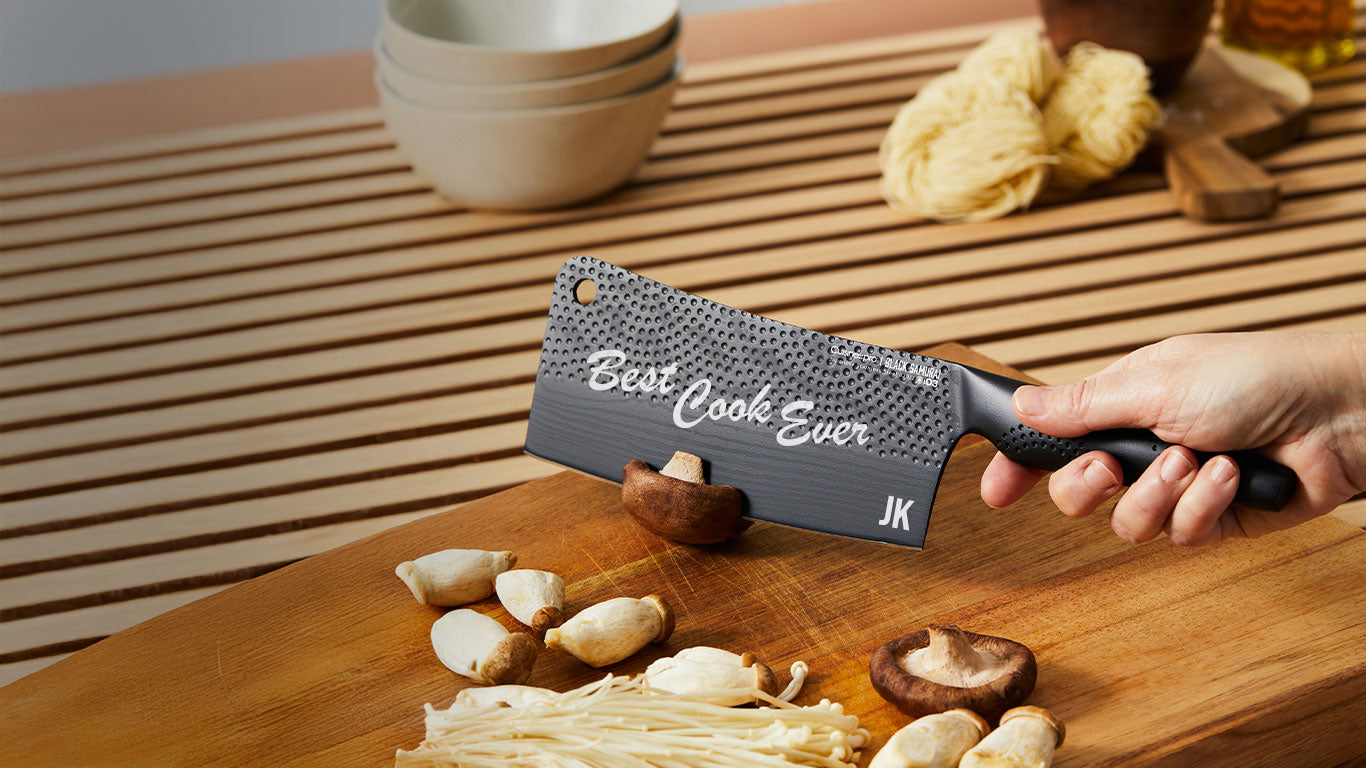The Difference Between Japanese and German Steel Knives
THE CUSTOM CHEF™ . June 11, 2025

Introduction
Not all knives are created equal and different knives have different advantages. So, depending on what you’re up to in the kitchen, one knife might be better suited to your task than another.
Knives are typically made with one of two kinds of steel: German steel or Japanese steel. And though both German and Japanese knives can be top notch in the kitchen, they vary in some important ways. Here, we’ll break down those differences.
Both types of steel have benefits and challenges, so we’ll walk you through how they’re made and the jobs at which they excel. We’ll also show you how best to take care of them, including how to safely sharpen and maintain their edges and store them when you’re done.
For your Japanese versus German steel primer, read on!
Japanese Steel vs. German Steel: What’s the Difference?
Japanese steel knives are known for being thin, lightweight, and precise. They’re typically half-tang knives—meaning the blade only extends halfway into the handle—which gives them a light and balanced feel in the hand. The blade’s slim shape makes Japanese steel knives easy to control and good at delicate or precision tasks.
German steel knives have weight and heft and are the best knife for meat prep, especially heavy-duty jobs like slicing through thick cuts of meat or bulky produce. Their thick blade usually extends all the way through the handle—known as a full-tang knife—giving them their strong, sturdy feel.
The hardness of a knife’s steel is one important element in its overall performance. This element is measured by the Rockwell hardness scale (HRC). Steel with a higher HRC (or hardness level) on the knife hardness scale is more durable and maintains its edge longer than metal with a lower HRC (so it requires less sharpening). These knives are also heavier and more balanced. THE CUSTOM CHEF™ German Steel brands have an HRC of 55.
Knives with lower HRCs use a have steel that is softer and more flexible steel. As a result, it can be crafted into a thinner blade and honed more easily. It’s also corrosion-resistant. THE CUSTOM CHEF™ Japanese Steel brands have an HRC of 53.
So, when does it make sense to reach for your German knife over your Japanese one? And vice versa? Good question!
Everyday Use: The Best Jobs for Japanese and German Steel
Grab a Japanese chef knife for any job that requires fine, delicate slicing—working with fish fillets, for example, or slicing herbs in a chiffonade cut. These precision knives are champions at slicing and dicing herbs and vegetables, quick prep work, and trimming slimmer cuts of fish and meat.
A German knife is a perfect partner for heftier tasks. Prepping squash for roasting? Cutting open a coconut? German steel’s sturdy strength will carry you through. More versatile than Japanese knives, German blades can be used for chopping, cutting, and slicing a variety of foods.
Product and Storage Options
If you’re a beginner cook building your kitchen tool kit, the versatility and stability of German kitchen knives make them a great starter set. THE CUSTOM CHEF™ has a variety of knife blocks with five to seven knives, kitchen shears and sharpening tools. Plus, the blocks themselves sit conveniently on the countertop, a safe, secure home when knives are not in use.
For those more experienced in the kitchen, Japanese knives offer a greater range of capability as you expand your skills and explore new recipes. Because these blades are slimmer and lighter, they store well on magnetic strips attached to a wall or cabinet. The magnet keeps blades separate so they won’t chip or get dinged up. They can also be stored in a minimalist knife block setup.
Care & Maintenance
Japanese steel has the ability to get razor sharp and its edge often stays sharp for a long time. But because its steel is so hard, these knives can be trickier to sharpen. A whetstone is the best knife sharpening technique, allowing you to finesse the ultra-thin edge. THE CUSTOM CHEF™ sharpeners feature diamond and ceramic wheels (with a honing and sharpening function), designed to replicate the precision achieved by a whetstone. You may also want to have your Japanese knives professionally sharpened a couple of times a year to maximize their full potential.
German steel will be slightly less sharp overall, but is also more forgiving. This traditionally softer type of steel is easier to sharpen at home and responds well to tabletop sharpeners and honing rods. Like Japanese steel, German knives also hold their edge well. Sharpen a few times a year and regularly hone before use.
As with all knives, wash and dry immediately after use and store safely separate from other knives and utensils (like in a block or on a magnetic strip) to avoid chips and dings in the blade.
What’s Your Best Knife Fit? Choosing Knives for Gifts and at Home
Lifestyle plays a role when you’re deciding how to start or add to your knife collection. The same goes for picking out gifts for family and friends. Are you learning how to cook or are you an experienced home chef? What foods do you like to make? Do you prefer tools that are lightweight and allow for greater precision? (Which might also be helpful if you have smaller hands….) Or do you need more versatile knives that can prep ribs for the grill as easily as they can chop cabbage for cole slaw?
German knives are a great fit for wedding and housewarming gifts. A set of these beginner-friendly knives will offer flexibility, easy sharpening and maintenance, and durability and be an ideal foundation for a starter kitchen.
For those in your life with well-established gourmet taste (and skills), a Japanese knife will be a welcome addition. These precision kitchen knives will instantly elevate food prep potential and become a prize possession.
As you make your choice, go with the blade that suits your (or your recipient’s) kitchen, cooking style, and taste. Whatever direction you decide will be an excellent one!
Conclusion
Japanese and German knives are undeniably both an asset in the kitchen. While Japanese steel delivers high levels of precision with its sharpness and lightweight handling, German steel is versatile and reliable, tackling a range of foods (especially hard-to-manage ones) with ease.
At THE CUSTOM CHEF™, select from knives made from the finest German Stainless Steel 1.4116, known for its durability and better edge performance. Our Japanese Stainless Steel 42OJ2 knives are easy to use and resistant to rust and corrosion.
Let your lifestyle dictate your choice, depending on your cooking comfort level and needs. Can’t decide? Get a mix of both knife styles! As your skills and confidence grow, a blend of German and Japanese knives will only complement your capabilities. Head to THE CUSTOM CHEF™ to explore our many options!
Related Articles
Discover All >




